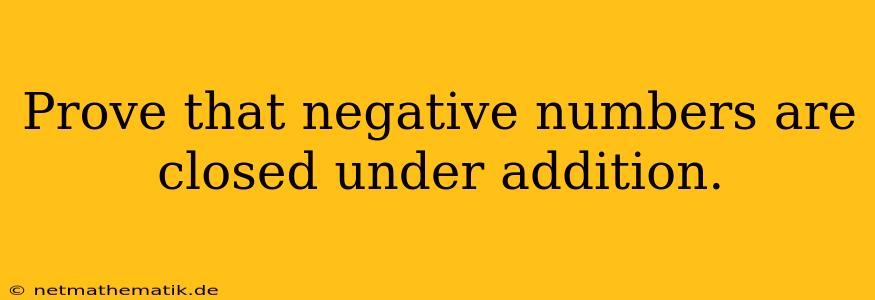The concept of closure in mathematics is crucial for understanding how operations behave within a set. In essence, closure means that when you apply a specific operation to elements within a set, the result will always be another element of the same set. This article delves into the property of closure with respect to addition, specifically focusing on negative numbers. We will explore why negative numbers are closed under addition, demonstrating this property through a combination of formal mathematical proof and intuitive explanation.
What Does "Closed Under Addition" Mean?
To understand why negative numbers are closed under addition, we first need to define what "closed under addition" actually means. A set of numbers is considered closed under addition if the sum of any two numbers within that set always results in another number that is also part of the same set. For instance, the set of natural numbers (1, 2, 3, ...) is closed under addition because the sum of any two natural numbers will always be another natural number. Let's explore why this principle applies to negative numbers.
The Number Line and Negative Numbers
Imagine a number line. Zero sits in the middle, with positive numbers stretching out to the right and negative numbers extending to the left. The key to understanding negative numbers is to think of them as representing quantities in the opposite direction from positive numbers. Adding a negative number is like moving to the left on the number line, while adding a positive number is like moving to the right.
Illustrating Closure with Examples
Let's demonstrate how closure works with negative numbers through a few examples:
- Example 1: (-3) + (-5) = (-8). Both -3 and -5 are negative numbers. Their sum, -8, is also a negative number.
- Example 2: (-2) + 4 = 2. While we start with a negative number (-2), the sum results in a positive number (2). However, this result is still within the set of integers, which includes both negative and positive numbers.
- Example 3: (-7) + (-1) = (-8). Again, the sum of two negative numbers yields another negative number.
Formal Proof of Closure
We can formally prove that negative numbers are closed under addition using the properties of integers and the concept of inverse elements.
Proof:
-
Definition: Let 'a' and 'b' be any two negative numbers. This means 'a' and 'b' are less than zero: a < 0 and b < 0.
-
Inverse Property: For every negative number, there exists a positive number that, when added, results in zero. For example, the inverse of -3 is +3 because (-3) + (+3) = 0. Let's denote the inverses of 'a' and 'b' as '-a' and '-b', respectively.
-
Sum of Inverses: We know that a + (-a) = 0 and b + (-b) = 0.
-
Adding the Equations: If we add the equations from step 3, we get: (a + (-a)) + (b + (-b)) = 0 + 0 Simplifying: a + b + (-a) + (-b) = 0
-
Rearranging Terms: Rearranging the terms: (a + b) + (-a) + (-b) = 0
-
Inverse of the Sum: Since (-a) and (-b) are the inverses of 'a' and 'b', respectively, we can rewrite the equation as: (a + b) + [-(a + b)] = 0.
-
Closure: This equation indicates that the sum of 'a' and 'b' (which is (a + b)) has an inverse element, namely -(a + b). This means that (a + b) is also a negative number.
Therefore, we have proven that the sum of any two negative numbers ('a' and 'b') is always another negative number. This proves that negative numbers are closed under addition.
Conclusion
Understanding why negative numbers are closed under addition is fundamental in mathematics. This property helps us to predict the outcome of adding negative numbers without needing to perform the actual addition. By understanding closure, we gain insights into the structure and behavior of the number system, enabling us to make accurate calculations and predictions in various mathematical contexts.
